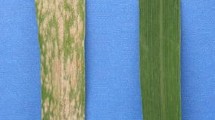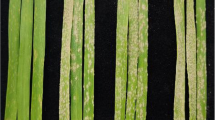Abstract
Powdery mildew caused by Blumeria graminis f. sp. tritici is one of the most important wheat diseases worldwide and breeding for resistance using diversified disease resistance genes is the most promising approach to prevent outbreaks of powdery mildew. A powdery mildew resistance gene, originating from wild emmer wheat (Triticum turgidum var. dicoccoides) accessions collected from Israel, has been transferred into the hexaploid wheat line 3D232 through crossing and backcrossing. Inoculation results with 21 B. graminis f. sp. tritici races indicated that 3D232 is resistant to all of the powdery mildew isolates tested. Genetic analyses of 3D232 using an F2 segregating population and F3 families indicated that a single dominant gene, Ml3D232, confers resistance in the host seedling stage. By applying molecular markers and bulked segregant analysis (BSA), we have identified polymorphic simple sequence repeats (SSR), expressed sequence tags (EST) and derived sequence tagged site (STS) markers to determine that the Ml3D232 is located on chromosome 5BL bin 0.59–0.76. Comparative genetic analyses using mapped EST markers and genome sequences of rice and Brachypodium established co-linearity of the Ml3D232 genomic region with a 1.4 Mb genomic region on Brachypodium distachyon chromosome 4, and a 1.2 Mb contig located on the Oryza sativa chromosome 9. Our comparative approach enabled us to develop new EST–STS markers and to delimit the genomic region carrying Ml3D232 to a 0.8 cM segment that is collinear with a 558 kb region on B. distachyon. Eight EST markers, including an NBS-LRR analog, co-segregated with Ml3D232 to provide a target site for fine genetic mapping, chromosome landing and map-based cloning of the powdery mildew resistance gene. This newly developed common wheat germplasm provides broad-spectrum resistance to powdery mildew and a valuable resource for wheat breeding programs.


Similar content being viewed by others
References
Bennett FGA (1984) Resistance to powdery mildew in wheat: a review of its use in agriculture and breeding programmes. Plant Pathol 33:279–300
Blanco A, Gadaleta A, Cenci A, Carluccio AV, Abdelbacki AM, Simeone R (2008) Molecular mapping of the novel powdery mildew resistance gene Pm36 introgressed from Triticum turgidum var. dicoccoides in durum wheat. Theor Appl Genet 117:135–142
Bossolini E, Wicker T, Knobel PA, Keller B (2007) Comparison of orthologous loci from small grass genomes Brachypodium and rice: implications for wheat genomics and grass genome annotation. Plant J 49:704–717
Chen X, Luo Y, Xia X, Xia L, Chen X, Ren Z, He Z, Jia J (2005) Chromosomal location of powdery mildew resistance gene Pm16 in wheat using SSR marker analysis. Plant Breed 124:225–228
Devos KM (2005) Updating the ‘Crop Circle’. Curr Opin Plant Biol 8:155–162
Distelfeld A, Uauy C, Olmos S, Schlatter AR, Dubcovsky J, Fahima T (2004) Microcolinearity between a 2-cM region encompassing the grain protein content locus Gpc-6B1 on wheat chromosome 6B and a 350-kb region on rice chromosome 2. Funct Integr Genom 4:59–66
Draper J, Mur LA, Jenkins G, Ghosh-Biswas GC, Bablak P, Hasterok R, Routledge AP (2001) Brachypodium distachyon. A new model system for functional genomics in grasses. Plant Physiol 127:1539–1555
Feuillet C, Travella S, Stein N, Albar L, Nublat A, Keller B (2003) Map-based isolation of the leaf rust disease resistance gene Lr10 from the hexaploid wheat (Triticum aestivum L.) genome. Proc Natl Acad Sci USA 100:15253–15283
Grama A, Gerechter-Amitai ZK (1974) Inheritance of resistance to stripe rust (Puccinia striiformis) in crosses between wild emmer (Triticum dicoccoides) and cultivated tetraploid and hexaploid wheats II Triticum aestivum. Euphytica 23:393–398
Guyot R, Yahiaoui N, Feuillet C, Keller B (2004) In silico comparative analysis reveals a mosaic conservation of genes within a novel colinear region in wheat chromosome 1AS and rice chromosome 5S. Funct Integr Genomics 4:47–58
He R, Chang Z, Yang Z, Yuan Z, Zhan H, Zhang X, Liu J (2009) Inheritance and mapping of powdery mildew resistance gene Pm43 introgressed from Thinopyrum intermedium into wheat. Theor Appl Genet 118:1173–1180
Hua W, Liu Z, Zhu J, Xie C, Yang T, Zhou Y, Duan X, Sun Q, Liu Z (2009) Identification and genetic mapping of a new recessive powdery mildew resistance gene Pm42 in wheat derived from wild emmer (Triticum turgidum var. dicoccoides). Theor Appl Genet 119:223–230
Huang X, Röder M (2004) Molecular mapping of powdery mildew resistance genes in wheat: a review. Euphytica 137:203–223
Huang L, Brooks SA, Li W, Fellers JP, Trick HN, Gill BS (2003) Map-based cloning of leaf rust resistance gene Lr21 from the large and polyploid genome of bread wheat. Genetics 164:655–664
Ji XL, Xie CJ, Ni ZF, Yang TM, Nevo E, Fahima T, Liu ZY, Sun QX (2007) Identification and genetic mapping of a powdery mildew resistance gene in wild emmer (Triticum dicoccoides) accession IW72 from Israel. Euphytica 159:385–390
Keller B, Feuillet C, Yahiaoui N (2005) Map-based isolation of disease resistance genes from bread wheat: cloning in a supersize genome. Genet Res Camb 85:93–100
Li GQ, Fang TL, Xie CJ, Yang TM, Nevo E, Fahima T, Sun QX, Liu ZY (2008) Molecular characterization of a new powdery mildew resistance gene Pm41 on chromosome 3BL derived from wild emmer (Triticum turgidum var. dicoccoides). Theor Appl Genet 119:531–539
Lincoln S, Daly M, Lander E (1992) Constructing genetic maps with Mapmaker/EXP3.0 Whitehead Institute Technical Report, 3rd edn. Whitehead Institute, Cambridge
Liu ZY, Sun QX, Ni ZF, Nevo E, Yang TM (2002) Molecular characterization of a novel powdery mildew resistance gene Pm30 in wheat originating from wild emmer. Euphytica 123:21–29
Luo PG, Luo HY, Chang ZJ, Zhang HY, Zhang M, Ren ZL (2009) Characterization and chromosomal location of Pm40 in common wheat: a new gene for resistance to powdery mildew derived from Elytrigia intermedium. Theor Appl Genet 118:1059–1064
McIntosh RA, Yamazaki Y, Dubcovsky J et al (2008) Catalogue of gene symbols for wheat. In Appels R, Eastwood R, Lagudah E et al (eds) Proceedings of 11th international wheat genet symposium. Sydney University Press, Sydney, Australia
Michelmore RW, Paran I, Kesseli VR (1991) Identification of markers closely linked to disease-resistance genes by bulked segregant analysis: a rapid method to detect markers in specific genomic regions by using segregating populations. Proc Natl Acad Sci USA 88:9828–9832
Mohler V, Zeller FJ, Wenzel G, Hsam SLK (2005) Chromosomal location of genes for resistance to powdery mildew in common wheat (Triticum aestivum L. em Thell.). 9. Gene MlZec1 from the Triticum dicoccoides-derived wheat line Zecoi-1. Euphytica 142:161–167
Moseman JG, Nevo E, El-Morshidy MA, Zohary D (1984) Resistance of Triticum dicoccoides collected in Isreal to infection with Erysiphe graminis tritici. Euphytica 33:41–47
Moseman JG, Nevo E, Gerechter-Amitai ZK, El-Morshidy MA, Zohary D (1985) Resistance of Triticum dicoccoides collected in Israel to infection with Puccinia recondita tritici. Crop Sci 25:262–265
Nevo E, Gerechter-Amitai ZK, Beiles A (1991) Resistance of wild emmer wheat to stem rust: ecological, pathological and allozyme associations. Euphytica 53:121–130
Nevo E, Korol AB, Beiles A, Fahima T (2002) Evolution of wild emmer and wheat improvement: population genetics, genetic resources, and genome organization of wheat’s progenitor, Triticum dicoccoides. Springer, Berlin
Qi LL, Echalier B, Chao S, Lazo GR, Butler GE et al (2004) A chromosome bin map of 16, 000 expressed sequence tag loci and distribution of genes among the three genomes of polyploid wheat. Genetics 168:701–712
Reader SM, Miller TE (1991) The introduction into bread wheat of a major gene for resistance to powdery mildew from wild emmer wheat. Euphytica 53:57–60
Röder MS, Korzun V, Wendehake K, Plaschke J, Tixier MH, Leroy P, Ganal MW (1998) A microsatellite map of wheat. Genetics 149:2007–2023
Rong JK, Millet E, Manisterski J, Feldman M (2000) A new powdery mildew resistance gene: introgression from wild emmer into common wheat and RFLP-based mapping. Euphytica 115:121–126
Saghai-Maroof MA, Soliman KM, Jorgensen RA, Allard RW (1984) Ribosomal DNA spacer-length polymorphisms in barley: Mendelian inheritance, chromosomal locations and population dynamics. Proc Natl Acad Sci USA 81:8014–8018
Somers DJ, Isaac P, Edwards K (2004) A high density microsatellite consensus map for bread wheat (Triticum aestivum L). Theor Appl Genet 109:1105–1114
Sorrells ME, La Rota M, Bermudez-Kandianis CE, Greene RA, Kantety R, Munkvold JD, Miftahudin M, Mahmoud A, Ma X, Gustafson PJ, Qi LL, Echalier B, Gill BS, Matthews DE, Lazo GR, Chao S, Anderson OD, Edwards H, Linkiewicz AM, Dubcovsky J, Akhunov ED, Dvorak J, Zhang D, Nguyen HT, Peng J, Lapitan NL, Gonzalez-Hernandez JL, Anderson JA, Hossain K, Kalavacharla V, Kianian SF, Choi DW, Close TJ, Dilbirligi M, Gill KS, Steber C, Walker-Simmons MK, McGuire PE, Qualset CO (2003) Comparative DNA sequence analysis of wheat and rice genomes. Genome Res 13:1818–1827
Sourdille P, Singh S, Cadalen T, Brown-Guedira GL, Gay G, Qi L, Gill BS, Dufour P, Murigneux A, Bernard M (2004) Microsatellite-based deletion bin system for the establishment of genetic-physical map relationships in wheat (Triticum aestivum L.). Funct Integr Genomics 4:12–25
Tanksley SD, Ganal MW, Martin GB (1995) Chromosome landing: a paradigm for map-based cloning in plants with large genomes. Trends Genet 11:63–68
The International Brachypodium Initiative (2010) Genome sequencing and analysis of the model grass Brachypodium distachyon. Nature 463:763–768
Turner A, Beales J, Faure S, Dunford RP, Laurie DA (2005) The pseudo-response regulator Ppd-H1 provides adaptation to photoperiod in barley. Science 310:1031–1034
Uauy C, Distelfeld A, Fahima T, Blechl A, Dubcovsky J (2006) A NAC gene regulating senescence improves grain protein, zinc, and iron content in wheat. Science 314:1298–1301
Wicker T, Yahiaoui N, Keller B (2007) Contrasting rates of evolution in Pm3 loci from three wheat species and rice. Genetics 177:1207–1216
Yahiaoui N, Srichumpa P, Dudler R, Keller B (2004) Genome analysis at different ploidy levels allows cloning of the powdery mildew resistance gene Pm3b from hexaploid wheat. Plant J 37:528–538
Yan L, Loukoianov A, Tranquilli G, Helguera M, Fahima T, Dubcovsky J (2003) Positional cloning of the wheat vernalization gene VRN1. Proc Natl Acad Sci USA 100:6263–6268
Yan L, Loukoianov A, Blechl A, Tranquilli G, Ramakrishna W, SanMiguel P, Bennetzen JL, Echenique V, Dubcovsky J (2004) The wheat VRN2 gene is a flowering repressor down-regulated by vernalization. Science. 303:1640–1644
Yan L, Fu D, Li C, Blechl A, Tranquilli G, Bonafede M, Sanchez A, Valarik M, Yasuda S, Dubcovsky J (2006) The wheat and barley vernalization gene VRN3 is an orthologue of FT. Proc Natl Acad Sci USA 103:19581–19586
Acknowledgments
The authors are grateful to Prof. Andrew Jackson, UC Berkeley, for improving the manuscript. This work was financially supported by the National Fund for Distinguished Young Scholars (30425039), National Natural Science Foundation of China (30771341, 30971780), MOA project 2009ZX08009-048B, the State High Tech Programs (2006AA100102, 2006AA10Z1E9, 2006AA10Z1C4, 2006BAD01A02), the Program of Introducing Talents of Discipline to Universities (111-2-03), and the Program for Changjiang Scholars and Innovative Research Teams in Universities. The aneuploid and deletion stocks gifts from Prof. B. S. Gill and Mr. W. J. Raupp, Wheat Genetics Resource Centre, Kansas State University, USA are gratefully acknowledged.
Author information
Authors and Affiliations
Corresponding authors
Additional information
Communicated by B. Keller.
H. Zhang, H. Guan and J. Li contributed equally to this work.
The seed stock of 3D232 has been deposited to gene bank of CIMMYT, Beijing, China. Request seeds of 3D232 should address to Dr. Zhonghu He, CIMMYT Beijing at zhhecaas@gmail.com or directly to Dr. Zhiyong Liu, China Agricultural University at zhiyongliu@cau.edu.cn.
Rights and permissions
About this article
Cite this article
Zhang, H., Guan, H., Li, J. et al. Genetic and comparative genomics mapping reveals that a powdery mildew resistance gene Ml3D232 originating from wild emmer co-segregates with an NBS-LRR analog in common wheat (Triticum aestivum L.). Theor Appl Genet 121, 1613–1621 (2010). https://doi.org/10.1007/s00122-010-1414-6
Received:
Accepted:
Published:
Issue Date:
DOI: https://doi.org/10.1007/s00122-010-1414-6




